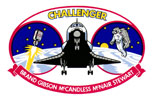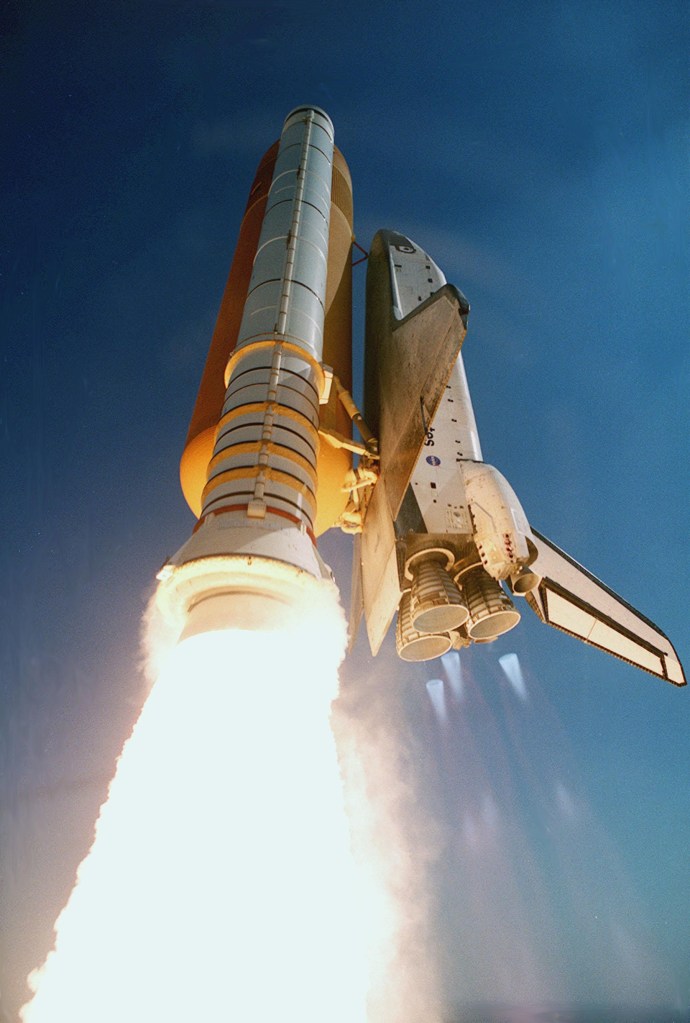
STS-41B
On this mission the first untethered space walks were carried out by Bruce McCandless and Robert Stewart, using the manned maneuvering unit.
Space Shuttle
mission duration
Launch
Landing

Mission Facts
Mission: WESTAR-VI, Manned Maneuvering Unit, PALAPA-B2, First KSC Landing
Space Shuttle: Challenger
Launch Pad: 39A
Launch Weight: 250,452 pounds
Launched: February 3, 1984 at 8:00:00 a.m. EST
Landing Site: Kennedy Space Center, Florida
Landing: February 11, 1984 at 7:15:55 a.m. EST
Landing Weight: 201,238 pounds
Runway: 15
Rollout Distance: 10,815 feet
Rollout Time: 67 seconds
Revolution: 128
Mission Duration: 7 days, 23 hours, 15 minutes, 55 seconds
Orbit Altitude: 189 nautical miles
Orbit Inclination: 28.5 degrees
Miles Traveled: 3.3 million
Mission Highlights
On this mission the first untethered space walks were carried out by McCandless and Stewart, using the manned maneuvering unit. The WESTAR-VI and PALAPA-B2 satellites were deployed, but failure of the Payload Assist Module-D (PAM-D) rocket motors left them in radical low-Earth orbits. The German-built Shuttle Pallet Satellite (SPAS), originally flown on STS-7, became the first satellite refurbished and carried back into space. SPAS remained in the payload bay due to an electrical problem with Remote Manipulator System (RMS). The RMS manipulator foot restraints were first used to practice procedures performed for Solar Maximum satellite retrieval and repair planned for next mission. Integrated Rendezvous Target (IRT) failed due to an internal issue. Five Get Away Special canisters flown in the cargo bay and Cinema-360 camera were used by crew. Other payloads included: Acoustic Containerless Experiment System (ACES); Monodisperse Latex Reactor (MLR); Radiation Monitoring Equipment (RME), and Isoelectric Focusing (IEF) payload.
Vance D. Brand
Commander
A recognized aerospace engineer and test pilot with almost 10,000 flying hours, Brand is perhaps best known as for his career as a NASA astronaut.

Robert L. Gibson
Pilot
Robert Lee “Hoot” Gibson (born October 30, 1946), (Capt, USN, Ret.), is a former American naval officer and aviator, test pilot, and aeronautical engineer.

Bruce McCandless II
Mission Specialist
Bruce McCandless II was a United States Navy officer and aviator, electrical engineer, and NASA astronaut. In 1984, during the first of his two Space Shuttle missions, he completed the first untethered spacewalk by using the Manned Maneuvering Unit.

Ronald E. McNair
Mission Specialist
Ronald McNair was nationally recognized for his work in laser physics and was one of the thirty-five applicants selected by NASA from a pool of ten thousand.

Robert L. Stewart
Mission Specialist
Stewart entered on active duty with the United States Army in May 1964 and was assigned as an air defense artillery director at the 32nd NORAD Region Headquarters (SAGE), Gunter Air Force Base, Alabama.

STS-41B
More About the Mission

In this photo taken on Feb. 8, 1984, NASA astronaut Ronald E. McNair plays his saxophone while off-duty during the…

On Feb. 3, 1984, space shuttle Challenger took off on its fourth flight, STS-41B. Its five-person crew of Commander Vance…

As astronaut Bruce McCandless II flew the Manned Maneuvering Unit (MMU) out of the space shuttle Challenger’s payload bay for…
Retired Space Shuttle Locations
Shuttle Atlantis – Kennedy Space Center Visitor Complex Shuttle Discovery – Steven F. Udvar-Hazy Center Shuttle Endeavour – California Science…
Read the Story











































